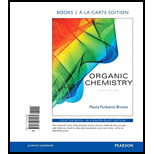
(a)
Interpretation:
Electrophiles and nucleophiles should be identified in the given
Concept introduction:
Nucleophiles are the electron rich species and it can share at least a pair of electron. Nucleophiles have negative charge.
Electrophiles are electron deficient species; they look for a pair of electrons. An electrophile has a positive charge, a partial positive charge or an incomplete octet that can accept electron.
(b)
Interpretation:
Electrophiles and nucleophiles should be identified in the given acid-base titration.
Concept introduction:
Nucleophiles are the electron rich species and it can share at least a pair of electron. Nucleophiles have negative charge.
Electrophiles are electron deficient species; they look for a pair of electrons. An electrophile has a positive charge, a partial positive charge or an incomplete octet that can accept electron.
Want to see the full answer?
Check out a sample textbook solution
Chapter 5 Solutions
Organic Chemistry, Books a la Carte Edition (8th Edition)
- The following pKa values have been measured. Explain why a hydroxyl group in the para position decreases the acidity while a hydroxyl group in the meta position increases the acidity.arrow_forwardi H Br OCH 3 step 1 Br-Br step 2 Br B D A C In step 2 of the reaction above, classify C and D as electrophile or nucleophile. Both C and D are acting as electrophiles. Both C and D are acting as nucleophiles. C is acting as the nucleophile, D is acting as the electrophile. OC is acting as the electrophile, D is acting as the nucleophile. HOCH 3arrow_forward14. Draw the two reactants used to form the following compound, label the nucleophile and the electrophile, and using arrows show the points of attack of the nucleophile on the electrophile that enables the formation of the heterocyclic product. Na2CO3, H2O NH2 А. H CH3 H CH3H CH3arrow_forward
- Indicate the correct reaction types for the reactions shown below: boo a a OH b b nucleophilic substitution esterification nucleophilic substitution Grignard hydration Grignard hydration esterificationarrow_forwardIdentify whether the hydroxide ion is functioning as a base or as a nucleophile. Но: O. :0: OH R. -R R.arrow_forward... G dou 1. What would be the best base for performing the elimination reaction shown? Br Br 1 / 1 2. What major product(s) will be yielded by the elimination reaction shown? Br NaOCH₂CH3 e 3. What is the product of the elimination reaction? OC(CH3)3 100% + 4. What is the predicted product of the elimination reaction shown? OH conc. H₂SO4 heatarrow_forward
- Predict the major products of the reaction of acetone with each of the following reagents: a. C2H3OH + H+ , Δ b. Zn (Hg) + conc. HCl, heat c. HCNarrow_forward9) The nitrile group is considerably less electrophilic than a carbonyl, and nitrile-stabilized anions are very nucleophilic. Draw the products of the following reactions. NaOH CN 0-100 °C NC. CN + excess NEt3, DMSOarrow_forwardWhich is the major product from the acid catalyzed hydrolysis of cyclohexene oxide? но OH но он || II IVarrow_forward
- Select all that belongs to "Electrophile" accepts an electron pair to form a bond donates an electron pair to form a bond Weak Lewis Acid Electron rich Electron poor Substitutes leaving group in Sn1 and Sn2 reactions Partially positive Strong Lewis Acid MacBook Air F6 F7 F8 F9 F10 F4 F5 % & 5 6 7 8arrow_forwardChoose the best reagents to complete the following reaction. $ H₂O OH $ < OH A B C D E NaOH H₂O H2, Raney nickel TSOH, H₂O (CH2OH)2, TSOH Donearrow_forward2a. Which of the following compounds is the strongest electrophile? HO, NH2 B Darrow_forward
 Chemistry & Chemical ReactivityChemistryISBN:9781133949640Author:John C. Kotz, Paul M. Treichel, John Townsend, David TreichelPublisher:Cengage Learning
Chemistry & Chemical ReactivityChemistryISBN:9781133949640Author:John C. Kotz, Paul M. Treichel, John Townsend, David TreichelPublisher:Cengage Learning Chemistry & Chemical ReactivityChemistryISBN:9781337399074Author:John C. Kotz, Paul M. Treichel, John Townsend, David TreichelPublisher:Cengage Learning
Chemistry & Chemical ReactivityChemistryISBN:9781337399074Author:John C. Kotz, Paul M. Treichel, John Townsend, David TreichelPublisher:Cengage Learning Organic ChemistryChemistryISBN:9781305580350Author:William H. Brown, Brent L. Iverson, Eric Anslyn, Christopher S. FootePublisher:Cengage Learning
Organic ChemistryChemistryISBN:9781305580350Author:William H. Brown, Brent L. Iverson, Eric Anslyn, Christopher S. FootePublisher:Cengage Learning



